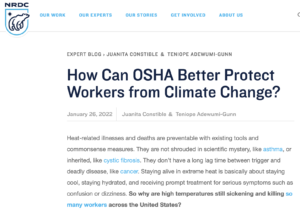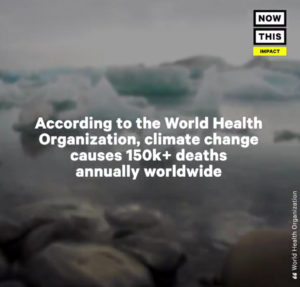https://www.nrdc.org/experts/juanita-constible/how-can-osha-better-protect-workers-climate-change
By Juanita Constible Teniope Adewumi-Gunn
Heat-related illnesses and deaths are preventable with existing tools and commonsense measures. They are not shrouded in scientific mystery, like asthma, or inherited, like cystic fibrosis. They don’t have a long lag time between trigger and deadly disease, like cancer. Staying alive in extreme heat is basically about staying cool, staying hydrated, and receiving prompt treatment for serious symptoms such as confusion or dizziness. So why are high temperatures still sickening and killing so many workers across the United States?
A major culprit is the lack of a federal occupational heat safety standard. Unlike other workplace hazards with their own specific and enforceable rules, such as ladders, noise, and cotton dust, unhealthy levels of heat are loosely regulated by the Occupational Safety and Health Administration (OSHA) under a vague part of federal law called the General Duty Clause.
That could soon change. After many years of advocacy by labor, faith, health, environmental, and other leaders, the Biden administration announced last September that OSHA would begin working on a federal heat injury and illness prevention standard. The public comment period for the first stage of rulemaking ends today. A clear, detailed, legally enforceable set of heat-related requirements for employers would help protect workers from restaurants in the Pacific Northwest, to construction sites in Texas, to warehouses in Maine, to farm fields in Florida.
Here is the TL;DR version of the public comments NRDC just submitted to OSHA about proposed heat standards.
- Heat affects the workforce with everything from missed wages, to debilitating injuries, to premature death.
- We don’t have the full picture of how heat harms U.S. workers because of chronic underreporting across federal and state health data systems. OSHA can and should use multiple data sources to better understand the scope and scale of heat-related harms to workers—but still consider those estimates as conservative.
- The current situation will worsen as the United States gets hotter, so heat standards must protect workers from current heat hazards and the future effects of climate change.
- Heat hurts outdoor and indoor workers across every major industry, so OSHA’s heat safety standard needs to protect all workers—not just those at the hottest outdoor worksites.
…
OSHA’s initial step to better protect workers from heat is heartening, but it’s also long overdue. The National Institute of Occupational Safety and Health, a research agency created by the Occupational Safety and Health Act of 1970, first recommended heat safety standards in 1972. The agency wrote that adherence to their recommended workplace requirements would:
“…prevent acute or chronic heat disorders and illnesses and heat induced unsafe acts, and will reduce the risk of harmful effects due to the interactions between excessive heat and toxic chemicals and physical agents.”
…
Full article here:
#
Related Links:
“Needless to say their numbers are the product of computer models, which have no relation with reality. But the long list of funders, including the NERC and the EU Horizon Project no doubt got the headlines they wanted.”
2016: Study: Heat Kills 9,000 in USA and Cold Kills 144,000
The current climate change death toll is 150,000 per year annually according to the World Health Organization. Climate change is projected to kill approximately 250,000 per year between 2030 and 2050.
#








